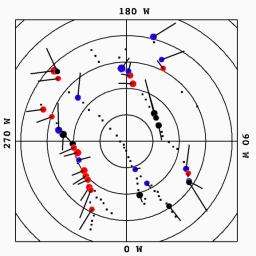Tendril-producing Geysers on Enceladus’ South Polar Terrain
Caption:
This graphic plots the source locations of the geysers scientists have located on Enceladus' south polar terrain. The 36 most active geyser, or jet, sources are marked by circles and color coded by the behavior of the grains erupting from the geysers. Other, less active sources are marked by small black squares.
Red sources produce structures that lead Enceladus in its orbit, blue sources produce particles that trail the moon, and black sources produce both. Circle size is proportional to the source activity level. Latitudes are plotted as concentric circles centered on the south pole at 5-degree intervals.
Lines emanating from sources represent the projection of a source's central emission vector onto Saturn's ringplane -- that is, the direction of a source's emission projected onto a plane passing through Saturn's equator. In this reference frame, Saturn is down and Enceladus' orbital motion to the right.
Background Info:
The Cassini mission is a cooperative project of NASA, ESA (the European Space Agency) and the Italian Space Agency. The Jet Propulsion Laboratory, a division of the California Institute of Technology in Pasadena, manages the mission for NASA's Science Mission Directorate, Washington. The Cassini orbiter and its two onboard cameras were designed, developed and assembled at JPL. The imaging operations center is based at the Space Science Institute in Boulder, Colorado.
For more information about the Cassini-Huygens mission visit
http://saturn.jpl.nasa.gov
and
http://www.nasa.gov/cassini
. The Cassini imaging team homepage is at
http://ciclops.org
.
Cataloging Keywords:
| Name |
Value |
Additional Values |
| Target |
Enceladus |
Saturn, Saturn Rings |
| System |
Saturn |
|
| Target Type |
Satellite |
Planet, Ring |
| Mission |
Cassini-Huygens |
|
| Instrument Host |
Cassini Orbiter |
|
| Host Type |
Orbiter |
|
| Instrument |
|
|
| Detector |
|
|
| Extra Keywords |
Color |
| Acquisition Date |
|
| Release Date |
2015-04-14 |
| Date in Caption |
|
|
| Image Credit |
NASA/JPL-Caltech/Space Science Institute |
| Source |
photojournal.jpl.nasa.gov/catalog/PIA17192 |
| Identifier |
PIA17192 |

 Planetary Data System
Planetary Data System
